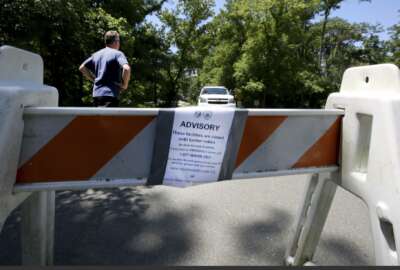
The post-shutdown chaotic wave is days from hitting many contractors
The Department of Homeland Security issued a notice to contractors setting expectations about the timing of solicitations and other acquisition activities for after...
While federal workers may be breathing a short sigh of relief now that the partial shutdown is over, contractors still are weeks from feeling relaxed.
The 35-day partial government shutdown undoubtedly pushed project milestones, due dates for solicitations and overall government spending well to the right. While all of these delays impact vendors, the real sigh of relief will come when agencies rescind stop work orders so contractors can send their employees back to work.
“Employees and contractors have to deal with the resets. Can all that get done in a day? Probably not. You will have clearance issues as people’s badges may not work. You will have to get funding straight, meaning the finance people will tell contracting officers that the funding is back on, but there may be nuances to the budget and it usually takes days to a week to say to an activity here is your money. Then the program office tells the contracting officer that the money is ready and then they can issue the go back to work order. Some can be easy and quick, others will require negotiations. Then the issue for the contractor is to have people are ready to go,” David Grant, a former associate administrator of the Mission Support Bureau at FEMA and now a partner with Potomac Ridge Consulting, said. “I think one to two days in the best case for contractors, while one to two weeks is not the best case. Getting ramped-up after a shutdown is a pain in the butt, but after a 35 day shutdown, it’s more complex.”
For some contractors, the Homeland Security Department offered some idea of what to expect once the shutdown ended.
DHS 3, 5, 7 day extensions
Related Stories

Government’s reputation as prompt bill payer among shutdown’s casualties

Senators introduce back pay legislation for low-wage federal contractors during shutdown
“If the particular RFP or RFQ established a deadline for submission of a proposal or quotation after Dec. 21, 2018 and the DHS funding lapse is not resolved prior to the deadline established in the RFP, then the proposal or quotations shall be due within seven business days following the resolution of the DHS funding lapse,” Correa wrote. “If the particular RFP or RFQ provided for the submission of questions, comments or other forms of inquiry after Dec. 21, 2018 and the DHS funding lapse is not resolved prior to the deadline established in the RFP for this type of submission, then the submission shall be due within five business days following resolution of the DHS funding lapse and resumption of business operations.”
Correa also said response to RFIs would be due three business days following resumption of DHS’s business operations.
Former DHS acquisition executives praised Correa for issuing the notice and setting clear expectations for contractors.
Jim Williams, the former DHS and General Services Administration executive, said the notice will help jump start the post-shutdown activities by giving vendors and DHS acquisition and program offices expectations to meet.
“Project and program baselines have to be reset, and that’s a long planning effort. You just can’t pick back up and it’s not a one-for-one loss in terms of days,” said Williams, now a partner with Schambach & Williams Consulting. “Re-planning will take a couple of days of meetings on the government side, and then sitting down with the contractors with the new metrics. Contractors will offer their insights because they want to get whole too, so they may want to add people. There will be tension in the room. New negotiations on these projects and programs is not as simple as moving them out 35 days.”
And given this reprieve may only last three weeks, contractors may not have a lot of time back on the job with those new deadlines.
Marc Pearl, the president and CEO of the Homeland Security and Defense Business Council, said vendors depend on DHS and other large agencies to have consistent and transparent planning. But the shutdown forces DHS to alter all of their previous work.
Pearl said vendors continue to be in a tough spot especially as the future remains so unclear.
“No one is talking about the long-term future.. They are in a day-trading mentality,” he said. “Many of our members who are doing business with DHS have contracts where they are providing services that support mission critical needs so they had to continue to work without funding. So they are borrowing money to pay those folks who are working, and can’t pay those folks that have been furloughed or where there is a stop work order.”
Vendors waiting to be paid
The Office of Management and Budget revised its guidance to agencies on Jan. 22 telling them to recall workers in order to get payments out to contractors who billed the government for work before Dec. 21.
Agencies didn’t have a lot of time, however, to get the vendor payment process up and running.
Experts say among the most important post-shutdown activities for many contractors, particularly the small business ones, is to get paid from previous work. While Congress may be discussing a bill to give low-wage contractors back pay, the likelihood of it passing anytime soon isn’t great.
“There will be a backlog of invoices that will need to be accepted and approved,” Grant said. “That combined with federal employee payroll and other things will swamp the finance office. They will be hard pressed to get it all done timely.”
Nick Nayak, the former DHS CPO and now president of Green Light Acquisition, said the one potential silver lining in the timing of the partial shutdown is procurement activity tends to be slower in late December into early January.
“We know that everything usually gets crammed into the second half of the fiscal year and, in many instances, the last quarter of the year, but the shutdown will make things much worse,” he said. “If the government is under a typical continuing resolution, then people at least are still working. But with this shutdown everything comes to a screeching halt and then add to it this one is the longest in history.”
Experts say no matter the timing of the shutdown, the pain it has inflicted on the contractor community is real and will be felt for months.
“There is no roadmap for how you do business with the government when there is a shutdown of this magnitude. What are the status of the programs? This will cause a lot of procurement reaction and if that’s the case, the ability to do long term planning is going to be jeopardized,” Pearl said. “We will see a panic and rush to spend at the last minute, which doesn’t go to long term consistency of the mission. It goes to being reactive again because agencies will be playing whack-a-mole because of what we missed in the second quarter of fiscal year.”
Read more of the Reporter’s Notebook
Copyright © 2025 Federal News Network. All rights reserved. This website is not intended for users located within the European Economic Area.
Jason Miller is executive editor of Federal News Network and directs news coverage on the people, policy and programs of the federal government.
Follow @jmillerWFED




